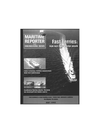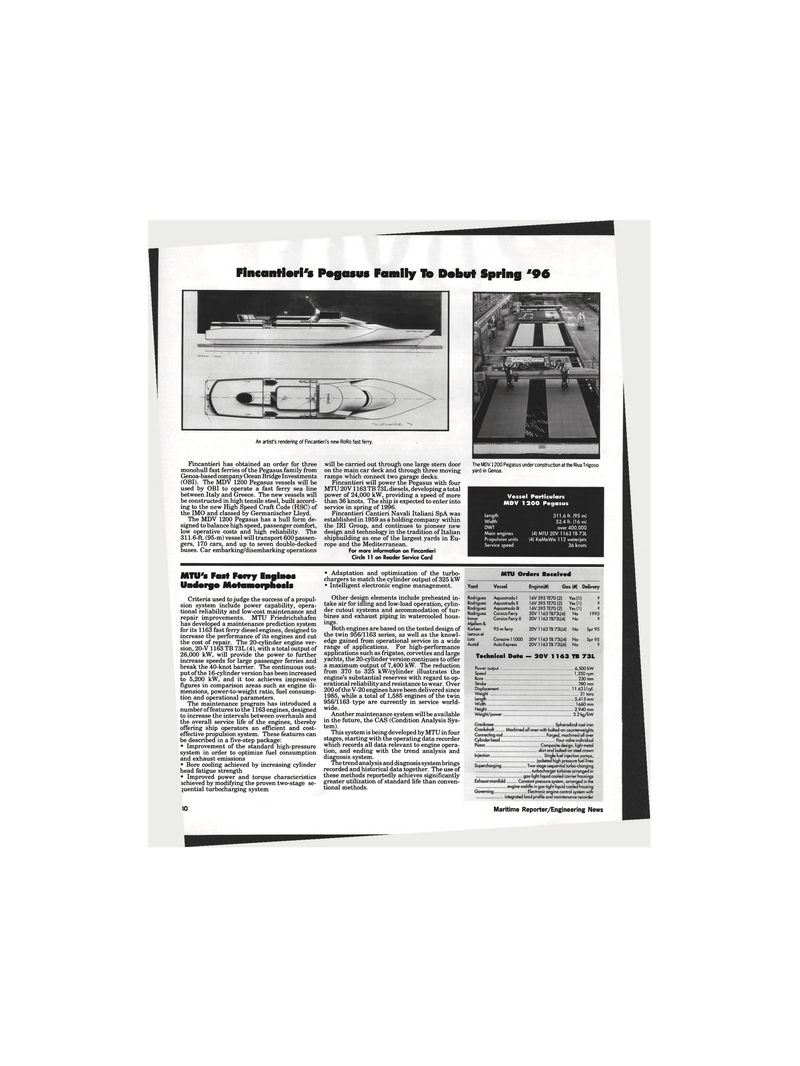
Page 28: of Maritime Reporter Magazine (May 1995)
Read this page in Pdf, Flash or Html5 edition of May 1995 Maritime Reporter Magazine
An artisfs rendering of Fincantieri's new RoRo fast ferry.
Fincantieri has obtained an order for three monohull fast ferries of the Pegasus family from
Genoa-based company Ocean Bridge Investments (OBI). The MDV 1200 Pegasus vessels will be used by OBI to operate a fast ferry sea line between Italy and Greece. The new vessels will be constructed in high tensile steel, built accord- ing to the new High Speed Craft Code (HSC) of the IMO and classed by Germanischer Lloyd.
The MDV 1200 Pegasus has a hull form de- signed to balance high speed, passenger comfort, low operative costs and high reliability. The 311.6-ft. (95-m) vessel will transport 600 passen- gers, 170 cars, and up to seven double-decked buses. Car emharking/disembarking operations will be carried out through one large stern door on the main car deck and through three moving ramps which connect two garage decks.
Fincantieri will power the Pegasus with four
MTU 20V1163 TB 73L diesels, developing a total power of 24,000 kW, providing a speed of more than 36 knots. The ship is expected to enter into service in spring of 1996.
Fincantieri Cantieri Navali Italiani SpA was established in 1959 as a holding company within the IRI Group, and continues to pioneer new design and technology in the tradition of Italian shipbuilding as one of the largest yards in Eu- rope and the Mediterranean.
For more information on Fincantieri
Circle 11 on Reader Service Card
The MDV 1200 Pegasus under construction at the Riva Trigoso yard in Genoa.
Fincantieri's Pegasus Family to Debut Spring '96
Vessel Particulars
MDV 1200 Pegasus
Length 311.6 ft. (95 m)
Width 52.4 ft. (16 m)
DWT over 400,000
Main engines (4) MTU 20V 1163 TB 73L
Propulsion units (4) KaMeWa 112 waterjets
Service speed 36 knots
MTU's Fast Ferry Engines
Undergo Metamorphesis
Criteria used to judge the success of a propul- sion system include power capability, opera- tional reliability and low-cost maintenance and repair improvements. MTU Friedrichshafen has developed a maintenance prediction system for its 1163 fast ferry diesel engines, designed to increase the performance of its engines and cut the cost of repair. The 20-cylinder engine ver- sion, 20-V 1163 TB 73L (4), with a total output of 26,000 kW, will provide the power to further increase speeds for large passenger ferries and break the 40-knot barrier. The continuous out- put of the 16-cylinder version has been increased to 5,200 kW, and it too achieves impressive figures in comparison areas such as engine di- mensions, power-to-weight ratio, fuel consump- tion and operational parameters.
The maintenance program has introduced a number of features to the 1163 engines, designed to increase the intervals between overhauls and the overall service life of the engines, thereby offering ship operators an efficient and cost- effective propulsion system. These features can be described in a five-step package: • Improvement of the standard high-pressure system in order to optimize fuel consumption and exhaust emissions • Bore cooling achieved by increasing cylinder head fatigue strength • Improved power and torque characteristics achieved by modifying the proven two-stage se- quential turbocharging system • Adaptation and optimization of the turbo- chargers to match the cylinder output of 325 kW • Intelligent electronic engine management.
Other design elements include preheated in- take air for idling and low-load operation, cylin- der cutout systems and accommodation of tur- bines and exhaust piping in watercooled hous- ings.
Both engines are based on the tested design of the twin 956/1163 series, as well as the knowl- edge gained from operational service in a wide range of applications. For high-performance applications such as frigates, corvettes and large yachts, the 20-cylinder version continues to offer a maximum output of 7,400 kW. The reduction from 370 to 325 kW/cylinder illustrates the engine's substantial reserves with regard to op- erational reliability and resistance to wear. Over 200 of the V-20 engines have been delivered since 1985, while a total of 1,585 engines of the twin 956/1163 type are currently in service world- wide.
Another maintenance system will be available in the future, the CAS (Condition Analysis Sys- tem).
This system is being developed by MTU in four stages, starting with the operating data recorder which records all data relevant to engine opera- tion, and ending with the trend analysis and diagnosis system.
The trend analysis and diagnosis system brings recorded and historical data together. The use of these methods reportedly achieves significantly greater utilization of standard life than conven- tional methods.
MTU Orders Received
Yard Vessel Engine(#) Gas (#) Delivery
Rodriguez Aquastrada 1 16V 595 TE70 (2) Yes(l) 8
Rodriguez Aquastrada II 16V 595 TE70 (2) Yes(l) 8
Rodriguez Aquastrada III 16V 595 TE70 (2) Yes(l) 8
Rodriguez Corsica Ferry 20V 1163 TB73L(4) No 1995
Inmar Corsica Ferry II 20V 1163 TB73L(4) No 8
Mjellem &
Karlsen 95-m ferry 20V 1163 TB 73L(4) No Spr 95
Leroux et
Lotz Corsaire 11000 20V 1163 TB 73L(4) No Spr 95
Austal Auto Express 20V 1163 TB 73L(4) No 8
Technical Data — 20V 1163 TB 73L
Power output 6,500 kW
Speed 1,250 rpm
Bore 230 mm
Stroke 280 mm
Displacement 11.631/cy!.
Weight 21 tons
Length 5,415 mm
Width 1660 mm
Height 2,940 mm
Weight/power 3.2 kg/kW
Crankcase Spherodical cast iron
Crankshaft Machined all over with bolted-on counterweights
Connecting rod Forged, machined all over
Cylinder head Four valve individual
Piston Composite design, light metal skirt and bolted-on steel crown
Injection Single fuel injection pumps, jacketed high pressure fuel lines
Supercharging Two-stage sequential turbo-charging turbocharger turbines arranged in gas-light liquid cooled carrier housings
Exhaust manifold Constant pressure system, arranged in the engine saddle in gas-tight liquid cooled housing
Governing Electronic engine control system with integrated load profile and maintenance recorder 50 Maritime Reporter/Engineering News

 27
27

 29
29
